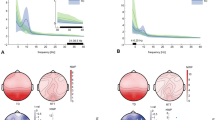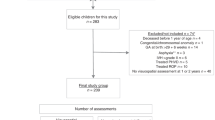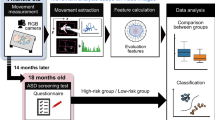Abstract
An apparently normal early development was one of the initial criteria for classical Rett syndrome. However, several investigators considered Rett syndrome to be a developmental disorder manifesting very soon after birth. Videos of 22 Rett cases were assessed carefully for movements, posture, and behavior during the first 6 mo of life. All signs that deviated from the normal standard were recorded meticulously. Special attention was paid to the face, the hands, and body movements. A detailed analysis clearly demonstrated an abnormal quality of general movements (100%), tongue protrusion (62%), postural stiffness (58%), asymmetric eye opening and closing (56%), abnormal finger movements (52%), hand stereotypies (42%), bursts of abnormal facial expressions (42%), bizarre smile (32%), tremor (28%), and stereotyped body movements (15%). Our study is the first to apply specific standardized measures of early spontaneous movements to Rett infants, proving conclusively that the disorder is manifested within the first months of life. Although not necessarily specific, the signs that we have observed will be of value in alerting clinicians to the possibility of the diagnosis at an early stage, when intervention is likely to be most effective.
Similar content being viewed by others
Log in or create a free account to read this content
Gain free access to this article, as well as selected content from this journal and more on nature.com
or
Abbreviations
- MECP2:
-
methyl-CpG-binding protein 2 gene
References
Amir RE, Van den Veyver IB, Wan M, Tran CQ, Francke U, Zoghbi HY 1999 Rett syndrome is caused by mutations in X-linked MECP2, encoding methyl-CpG-binding protein 2. Nat Genet 23: 185–188
Hagberg B, Aicardi J, Dias K, Ramos O 1983 A progressive syndrome of autism, dementia, ataxia, and loss of purposeful hand use in girls: Rett's syndrome: report of 35 cases. Ann Neurol 14: 471–479
Naidu S 1997 Rett syndrome: A disorder affecting early brain growth. Ann Neurol 42: 3–10
Huppke P, Held M, Laccone F, Hanefeld F 2003 The spectrum of phenotypes in females with Rett syndrome. Brain Dev 25: 346–351
Kerr AM, Nomura Y, Armstrong D, Anvret M, Belichenko PV, Budden S, Cass H, Christodoulou J, Clarke A, Ellaway C, d'Esposito M, Francke U, Hulten M, Julu P, Leonard H, Naidu S, Schanen C, Webb T, Engerstrom IW, Yamashita Y, Segawa M 2001 Guidelines for reporting clinical features in cases with MECP2 mutations. Brain Dev 23: 208–211
Kerr AM 1995 Early clinical signs in Rett disorder. Neuropediatrics 26: 67–71
Nomura Y, Segawa M 1990 Clinical features of the early stage of the Rett syndrome. Brain Dev 12: 16–19
Witt-Engerström I 1987 Rett syndrome: a retrospective pilot study on potential early predictive symptomatology. Brain Dev 9: 481–486
Kerr AM, Montague J, Stephenson JB 1987 The hands, and the mind, pre- and postregression, in Rett syndrome. Brain Dev 9: 487–490
Leonard H, Bower C 1998 Is the girl with Rett syndrome normal at birth?. Dev Med Child Neurol 40: 115–121
Carmagnat-Dubois F, Desombre H, Perrot A, Roux S, Le Noir P, Sauvage D, Garreau B 1997 Rett syndrome and autism. Early comparative evaluation for signs of autism using family movies. Encephale 23: 273–279
Holm VA 1985 Rett's syndrome: a progressive developmental disability in girls. J Dev Behav Pediatr 6: 32–36
Prechtl HF 2001 General movement assessment as a method of developmental neurology: new paradigms and their consequences. The Ronnie MacKeith lecture. Dev Med Child Neurol 43: 836–842
Einspieler C, Prechtl HF, Ferrari F, Cioni G, Bos AF 1997 The qualitative assessment of general movements in preterm, term and young infants—review of the methodology. Early Hum Dev 50: 47–60
Prechtl HF, Einspieler C, Cioni G, Bos AF, Ferrari F, Sontheimer D 1997 An early marker for neurological deficits after perinatal brain lesions. Lancet 349: 1361–1363
Prechtl HF 2001 Prenatal and postnatal development of human motor behaviour. In: Kalverboer AF, Gramsbergen A (eds) Handbook of Brain and Behaviour in Human Development. Kluwer Academic Publishers, Dordrecht, pp 415–428
Einspieler C, Cioni G, Paolicelli PB, Bos AF, Dressler A, Ferrari F, Roversi MF, Prechtl HF 2002 The early markers for later dyskinetic cerebral palsy are different from those for spastic cerebral palsy. Neuropediatrics 33: 73–78
Segawa M 2001 Discussant—pathophysiologies of Rett syndrome. Brain Dev 23( suppl 1): S218–S223
Konishi Y, Prechtl HF 1994 Finger movements and finger postures in preterm infants are not a good indicator of brain damage. Early Hum Dev 36: 89–100
Hennequin M, Allison PJ, Veyrune JL 2000 Prevalence of oral health problems in a group of individuals with Down syndrome in France. Dev Med Child Neurol 42: 691–698
Buntix IM, Hennekam RC, Brouwer OF, Stroink H, Beuten J, Mangelschots K, Fryns JP 1995 Clinical profile of Angelman syndrome at different ages. Am J Med Genet 56: 176–183
Calleja-Perez B, Fernandez-Jaen A, Martinez-Bermejo A, Pascual-Castroviejo I 1998 Joubert syndrome: a report of 5 cases. Rev Neurol 152: 548–550
Giroux B, Metz C, Giroux JD, de Parscau L 1997 Neonatal detection of central hypothyroidism. Arch Pediatr 6: 542–546
Burford B, Kerr AM, Macleod HA 2003 Nurse recognition of early deviation in development in home videos of infants with Rett disorder. J Intellect Disabil Res 47: 588–596
Armstrong D 2001 Rett syndrome neuropathology review 2000. Brain Dev 23( suppl 1): S72–S76
Shahbazian MD, Antalffy B, Armstrong DL, Zoghbi HY 2002 Insight into Rett syndrome: MeCP2 levels display tissue- and cell-specific differences and correlate with neuronal maturation. Hum Mol Genet 11: 115–124
Acknowledgements
We are grateful to Diana Eastbourne-Ludlam, vision therapist (Portland, OR, USA) for a second opinion on the asymmetry of eye opening and closing, to Prof. Arend Bos, Neonatologist (University Hospital Groningen, the Netherlands) for providing a third opinion in assessing the quality of fidgety movements in the infant for whom interscorer agreement was lacking, and to Peter B. Marschik, Ph.D. student, for assistance in preparing the manuscript.
We extend our sincere gratitude to the families who provided us with the videotapes that we analyzed for this article. Their good will and cooperation made this work possible.
Author information
Authors and Affiliations
Corresponding author
Additional information
This study was supported partly by the General Movement Trust. A.M.K.'s work has been supported by the Scottish, UK, and International Rett Associations.
Rights and permissions
About this article
Cite this article
Einspieler, C., Kerr, A. & Prechtl, H. Is the Early Development of Girls with Rett Disorder Really Normal?. Pediatr Res 57, 696–700 (2005). https://doi.org/10.1203/01.PDR.0000155945.94249.0A
Received:
Accepted:
Issue date:
DOI: https://doi.org/10.1203/01.PDR.0000155945.94249.0A
This article is cited by
-
Non-Verbal Social Skills Assessment in Rett Syndrome: a Systematic Review
Review Journal of Autism and Developmental Disorders (2023)
-
Early alterations in a mouse model of Rett syndrome: the GABA developmental shift is abolished at birth
Scientific Reports (2019)
-
Movement Disorders and Syndromic Autism: A Systematic Review
Journal of Autism and Developmental Disorders (2019)
-
Canonical Babbling: A Marker for Earlier Identification of Late Detected Developmental Disorders?
Current Developmental Disorders Reports (2019)
-
Rett syndrome: insights into genetic, molecular and circuit mechanisms
Nature Reviews Neuroscience (2018)



